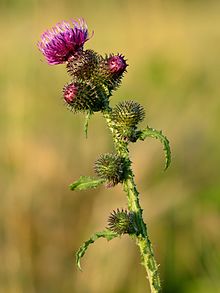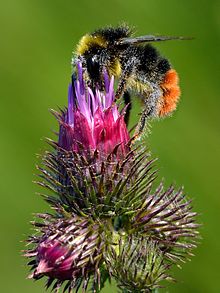Curled ring thistle
| Curled ring thistle | ||||||||||||
|---|---|---|---|---|---|---|---|---|---|---|---|---|

Curled ring thistle ( Carduus crispus ) |
||||||||||||
| Systematics | ||||||||||||
|
||||||||||||
| Scientific name | ||||||||||||
| Carduus crispus | ||||||||||||
| L. |
The frilled ring thistle or frilled thistle ( Carduus crispus ) is a species of the genus of ring thistles ( Carduus ) within the sunflower family (Asteraceae).
description
The Krause thistle grows as a biennial herbaceous plant that reaches heights of 0.5 to 2 meters. It is a hemicryptophyte . The stem is upright, moderately well-branched and winged narrowly, frizzy and thorny, or even just a few millimeters without thorns.
The stem leaves are alternate, pinnate, sessile with a narrow base, glabrous or almost glabrous on the top, dull dark green, white or gray-tomentose underneath or - rarely - at least tomentose almost to the edge of the leaf (then the leaf veins are occasionally less tomentose and greenish).
The flowering period extends from July to September. Usually three to five, rarely fewer or more, short-stalked, cup-shaped inflorescences are at the end of the stem and the branches. The flower heads are 1.5 to 2.5 cm long and about 3/4 as thick. The bracts are multi-row, almost needle-shaped and narrow and run into a thin, barely 1 mm long spine . They are protruding, the lower ones also slightly bent back, rarely covered with spider webs. There are only tubular flowers that are hermaphrodite and purple in color.
The achenes are about 3 mm long. The pappus consists of white hairs about 1 cm long that are not feathery.
The number of chromosomes is 2n = 16.
Occurrence
The general distribution of the frilled thistle extends from France to Norway, south to northern Italy and Bulgaria, east to the Caucasus and Siberia and over Mongolia to China.
Synanthrope inhabits the Krause Thistle Great Britain, North America and New Zealand, probably also Mongolia and Japan.
The curled thistle grows in creek meadows at the edges of fields, forests and roads, on railway areas and rubble sites as well as in open, disturbed, nitrogen-affected areas. It thrives on fresh to moist, nutrient-rich, humus-rich to sandy loam or clay soils . In the lowlands it is absent in certain areas, as is the case in the rougher areas of the low mountain ranges, the foothills of the Alps and the Alps; otherwise it appears absent-minded and often in loose stocks of moderately rich individuals. It rarely thrives at altitudes above 1000 meters. In the Allgäu Alps, it rises in Vorarlberg near Hochtannberg up to 1670 m above sea level. In terms of plant sociology , it is a class characteristic of the persistent ruderal societies (Artemisietea) with a focus on the order Convolvuletalia.
Systematics
One can distinguish the following subspecies:
- Carduus crispus L. subsp. crispus
- Carduus crispus subsp. multiflorus (Gaudin) Franco : It occurs in Spain, France, Belgium, Great Britain, Ireland, the Netherlands, Germany, Switzerland and Romania.
Common names
For the Krause ring thistle there are or existed, in some cases only regionally, the other German-language trivial names : Kratzdistel, Ruchdistle ( Switzerland ) and Wolfsdistle (Switzerland).
literature
- Dietmar Aichele, Heinz-Werner Schwegler: The flowering plants of Central Europe. Volume 4: nightshade plants to daisy plants . Franckh-Kosmos, Stuttgart 1995, ISBN 3-440-06194-9 .
- Oskar Sebald, Siegmund Seybold, Georg Philippi, Arno Wörz (eds.): The fern and flowering plants of Baden-Württemberg . tape 6 : Special part (Spermatophyta, subclass Asteridae): Valerianaceae to Asteraceae . Eugen Ulmer, Stuttgart (Hohenheim) 1996, ISBN 3-8001-3343-1 .
- Ruprecht Düll , Herfried Kutzelnigg : Pocket dictionary of plants in Germany and neighboring countries. The most common Central European species in portrait . 7th, corrected and enlarged edition. Quelle & Meyer, Wiebelsheim 2011, ISBN 978-3-494-01424-1 .
Individual evidence
- ↑ a b Erich Oberdorfer : Plant-sociological excursion flora for Germany and neighboring areas . With the collaboration of Angelika Schwabe and Theo Müller. 8th, heavily revised and expanded edition. Eugen Ulmer, Stuttgart (Hohenheim) 2001, ISBN 3-8001-3131-5 , pp. 963 .
- ↑ Erhard Dörr, Wolfgang Lippert : Flora of the Allgäu and its surroundings. Volume 2, IHW, Eching 2004, ISBN 3-930167-61-1 , p. 637.
- ↑ a b Werner Greuter (2006+): Compositae (pro parte majore). - In: W. Greuter & E. von Raab-Straube (ed.): Compositae. Euro + Med Plantbase - the information resource for Euro-Mediterranean plant diversity. Data sheet Carduus crispus In: Euro + Med Plantbase - the information resource for Euro-Mediterranean plant diversity.
- ^ Georg August Pritzel , Carl Jessen : The German folk names of plants. New contribution to the German linguistic treasure. Philipp Cohen, Hannover 1882, page 80. ( online ).
Web links
- Curled ring thistle. In: FloraWeb.de.
- Curled ring thistle . In: BiolFlor, the database of biological-ecological characteristics of the flora of Germany.
- Profile and distribution map for Bavaria . In: Botanical Information Hub of Bavaria .
- Carduus crispus L. In: Info Flora , the national data and information center for Swiss flora .
- Distribution in the northern hemisphere from: Eric Hultén, Magnus Fries: Atlas of North European vascular plants. 1986, ISBN 3-87429-263-0 at Den virtuella floran. (Swedish).
- Thomas Meyer: Thistle data sheet with identification key and photos at Flora-de: Flora von Deutschland (old name of the website: Flowers in Swabia )



